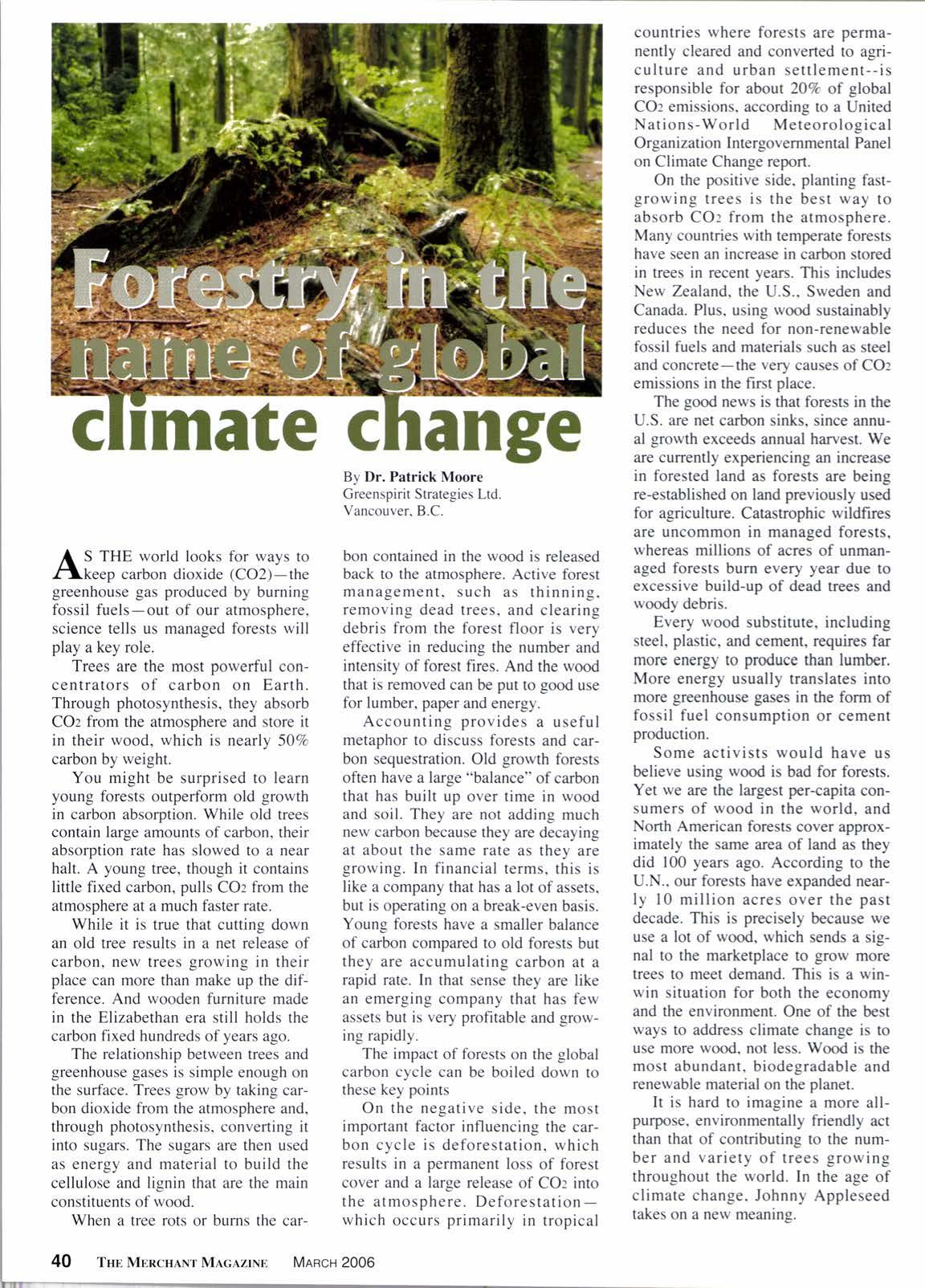
4 minute read
mate c
By Dr. Patrick Moore Greenspirit Strategies Ltd. Vancouver. B.C.
A S THE world looks for ways to la.keep carbon dioxide (CO2)-the greenhouse gas produced by burning fossil fuels-out of our atmosphere, science tells us managed forests will play a key role.
Trees are the most powerful concentrators of carbon on Earth. Through photosynthesis, they absorb COz from the atmosphere and store it in their wood, which is nearly 507o carbon by weight.
You might be surprised to learn young forests outperform old growth in carbon absorption. While old trees contain large amounts of carbon, their absorption rate has slowed to a near halt. A young tree, though it contains little fixed carbon, pulls COz from the atmosphere at a much faster rate.
While it is true that cutting down an old tree results in a net release of carbon, new trees growing in their place can more than make up the difference. And wooden furniture made in the Elizabethan era still holds the carbon fixed hundreds of years ago.
The relationship between trees and greenhouse gases is simple enough on the surface. Trees grow by taking carbon dioxide from the atmosphere and, through photosynthesis. converting it into sugars. The sugars are then used as energy and material to build the cellulose and lignin that are the main constituents of wood.
When a tree rots or burns the car- bon contained in the wood is released back to the atmosphere. Active forest management, such as thinning, removing dead trees, and clearing debris from the forest floor is very effective in reducing the number and intensity of forest fires. And the wood that is removed can be put to good use for lumber, paper and energy.
Accounting provides a useful metaphor to discuss forests and carbon sequestration. Old growth forests often have a large "balance" ofcarbon that has built up over time in wood and soil. They are not adding much new carbon because they are decaying at about the same rate as they are grorving. In financial terms, this is like a company that has a lot of assets. but is operating on a break-even basis. Young forests have a smaller balance of carbon compared to old forests but they are accumulating carbon at a rapid rate. In that sense they are like an emerging company that has few assets but is very profitable and grorving rapidly.
The impact of forests on the global carbon cycle can be boiled down to these key points
On the negative side, the most important factor influencing the carbon cycle is deforestation, rvhich results in a permanent loss of forest cover and a large release of CO: into the atmosphere. Deforestationwhich occurs primarily in tropical countries where forests are permanently cleared and converted to agriculture and urban settlement--is responsible for about 2O% of global CO: emissions, according to a United Nations-World Meteorological Organization Intergovernmental Panel on Climate Change report.
On the positive side. planting fastgrorving trees is the best way to absorb CO: from the atmosphere. Many countries rvith temperate forests have seen an increase in carbon stored in trees in recent years. This includes Nerv Zealand. the U.S.. Srveden and Canada. Plus. using wood sustainably reduces the need for non-renewable fossil fuels and materials such as steel and concrete-the very causes of CO: emissions in the first place.
The good news is that forests in the U.S. are net carbon sinks, since annual grorvth exceeds annual harvest. We are cunently experiencing an increase in forested land as forests are being re-established on land previously used for agriculture. Catastrophic rvildfires are uncommon in managed forests, whereas millions of acres of unmanaged forests burn every year due to excessive build-up of dead trees and woody debris.
Every rvood substitute, including steel, plastic, and cement, requires far more energy to pnrduce than lumber. More energy usually translates into more greenhouse gases in the form of fossil fuel consumption or cement production.
Some activists would have us believe using wood is bad for forests. Yet we are the largest per-capita consumers of wood in the world, and North American forests cover approximately the same area of land as they did 100 years ago. According to the U.N.. our forests have expanded nearly l0 million acres over the past decade. This is precisely because we use a lot of rvood, which sends a signal to the marketplace to grorv more trees to meet demand. This is a winrvin situation for both the economy and the environment. One of the best ways to address climate change is to use more rvood. not less. Wood is the most abundant. biodegradable and renervable material on the planet.
It is hard to imagine a more allpurpose. environmentally friendly act than that of contributing to the number and variety of trees grorving throughout the rvorld. In the age of climate change. Johnny Appleseed takes on a nerv meaning.

Montana Dealer Moves lnto New Home

Kenvon Noble Builcling Supplr Ccntcr has relocated to spacious nel quilrters in Boze'nran. Mt.
Thc ncln location. *hich opencd .lan. 13. has -5i.0(X) sc1. ft. of salcs spacc thc old facilitr hrtl 7.000. Thcrc's also -i-1.(XX) sq. l't. ol' * urchouse roor.t.t (Lrp l'rrrrn l-1.(XX)t. all on Itl acrcs. uith plcntr tlt'parkins: lirr u changc. inste-arl of thc cram1.r.'d l.-i acrcs thc- old rlonntonn facilitr rrrr: scltrcczccl ort to.
This r car ulso nrarks thc i.tlllli\cf\llt\ ()l lll(' \'otlll)ittl\'\ runcl irtcorlronttion tltouSlt thc ncss rlutcs [-rae k to lSS9 u' Kcnr on [-urnbcr [)culcr.
C'o-ori ncrs Rick and Bill
I ()()rh
Ilillll!' ftttsr-
S. C' Og lc dc.eitlctl t(r nt()\ c l\\ \r \ clrr\ ltg(). ilt llll t t() tttrtkc rtrrrttt lor lr ltropo:ctl (l()\\ Iltt)\\ t't 1lg1l1r1111 itlS ill't\ !CtltCf \\ ith the lrrt\ e dlttcr pro.jcrt .irre c s'aneclctl. thc OSlc. ure Lll)rlr!irlc(l l\ t() rr hut thcr rr i|| tltr rr ith the \ u! irtcrl t;.reilitr lrut nr()rc thrrn Plcu'e.l tl'tlrt the r nrlrtlc thc rnor c.










